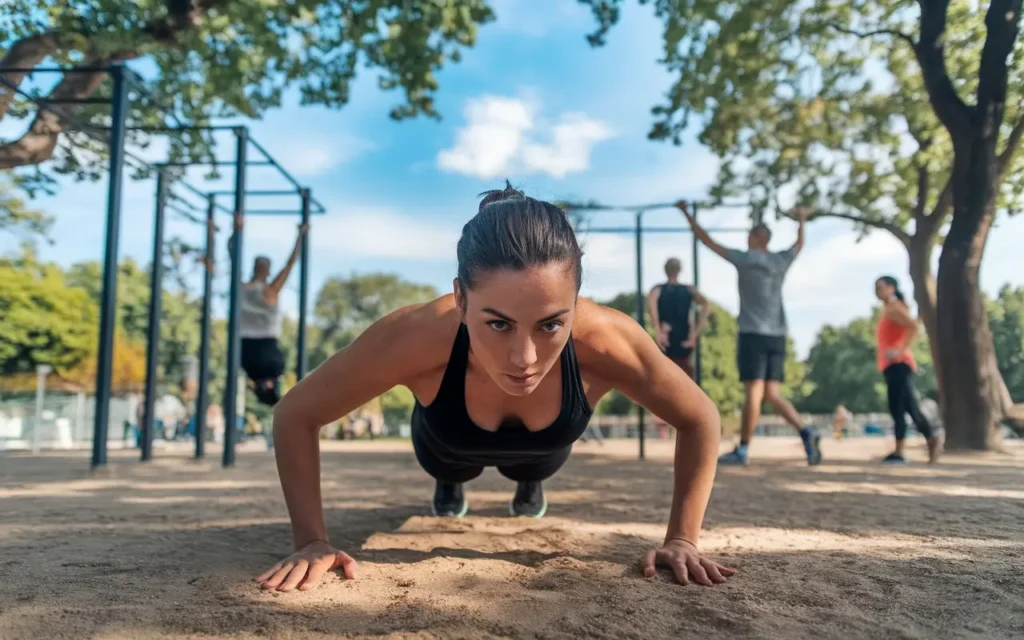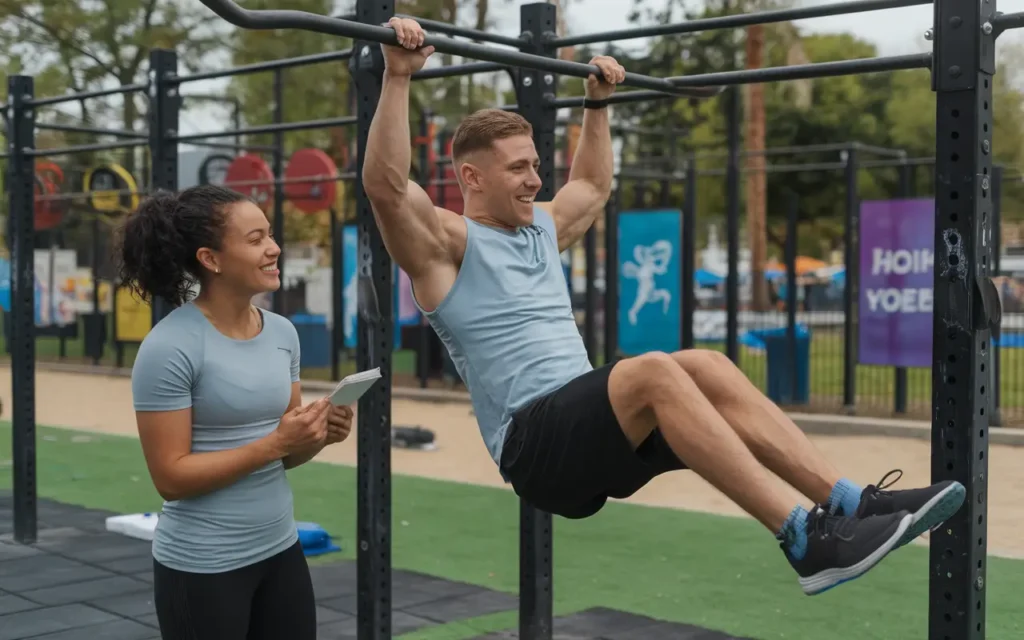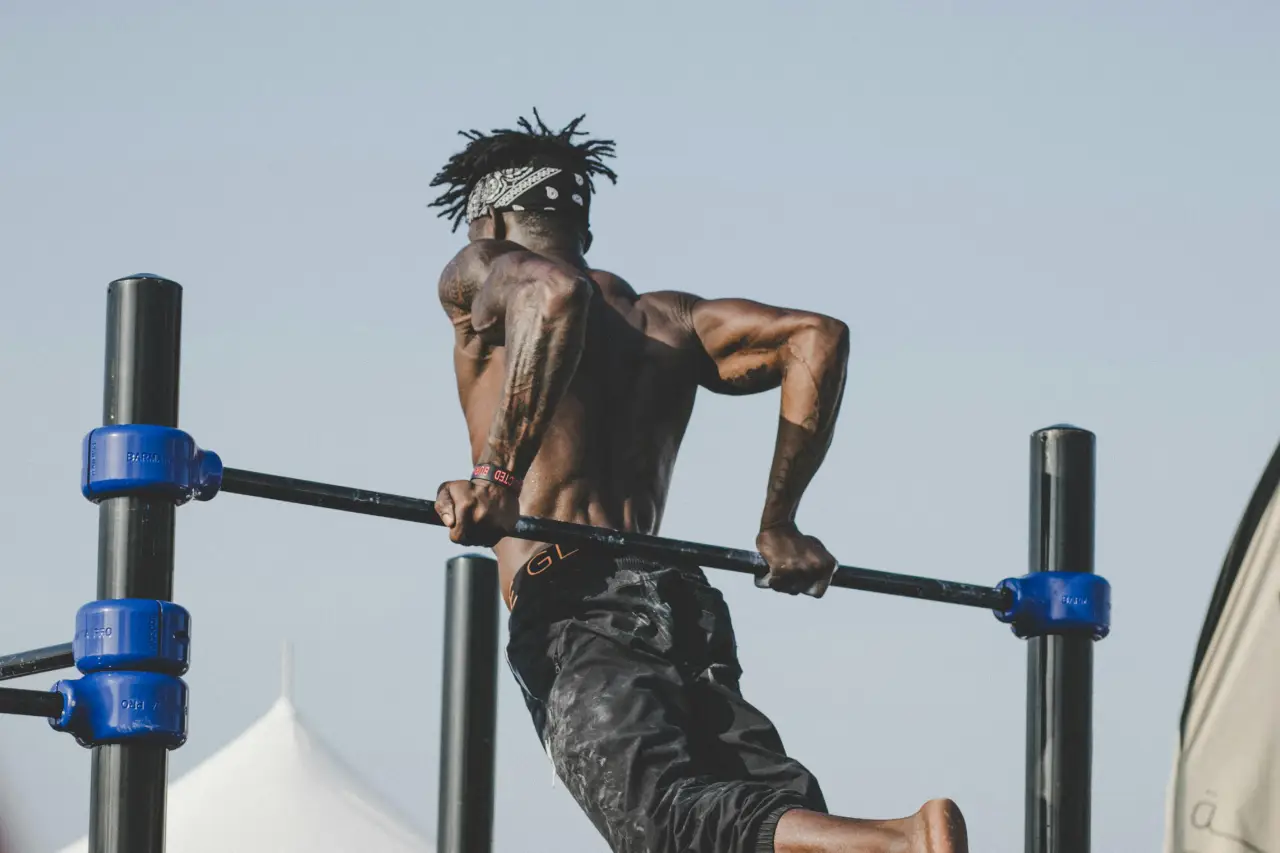Are you looking to get fit without the constraints of expensive gym memberships or heavy weights? Calisthenics, a powerful way to build muscle, improve endurance, and enhance mobility, allows you to exercise anywhere, anytime, using only your body weight. Whether you’re a beginner or advanced athlete, a calisthenics workout plan puts you in control of your fitness journey.
In this guide, we’ll cover everything from beginner routines to advanced workouts, common mistakes to avoid, and how to progress effectively. Ready to transform your body? Let’s dive in!
What is Calisthenics?

Calisthenics is a dynamic form of strength training that emphasizes using bodyweight exercises rather than external weights or gym equipment. This training method incorporates various movements, including push-ups, pull-ups, squats, lunges, and dips, each specifically designed to enhance functional strength, flexibility, mobility, and endurance.
One of the most notable aspects of calisthenics is its focus on full-body movement patterns. This approach builds strength and improves overall body coordination and balance, making it highly beneficial for athletes, martial artists, and fitness enthusiasts. By engaging multiple muscle groups simultaneously, calisthenics promotes the development of natural strength that translates well into real-world activities and sports.
Additionally, calisthenics is suitable for everyone, regardless of fitness level. Both beginners and advanced practitioners can customize their workouts. Progressions and variations allow continuous development as strength and skills improve. Moreover, with no need for gym facilities or equipment, calisthenics can be conveniently performed anywhere—from parks to home environments—encouraging consistency and sustainability in one’s fitness journey. Whether one’s goals include weight loss, muscle gain, or improved athletic performance, calisthenics provides a versatile and practical training approach.
Why Choose a Calisthenics Workout Plan?
Calisthenics is not just about doing random bodyweight exercises—it’s about following a structured workout plan that ensures progression and results. Here’s why you should consider calisthenics:
- No Equipment Needed – You can train anywhere, anytime.
- Functional Strength – Improves coordination, balance, and flexibility.
- Progressive Overload – You can modify exercises to increase difficulty as you get stronger.
- Burns Fat & Builds Muscle – Helps you get lean and muscular without weights.
- Reduces Injury Risk – Low-impact exercises protect your joints while strengthening them.
Whether your purpose is muscle building, weight loss, or improved endurance, a calisthenics workout plan can help you achieve these objectives efficiently.
Best Exercises for a good calisthenics workout plan

To get the most out of your calisthenics workout plan, you need to master some key exercises. These movements work multiple muscle groups, helping you build strength, endurance, and mobility.
1. Push-Ups
Push-ups are an effective exercise that primarily targets the chest, shoulders, and triceps. Additionally, they engage the core muscles, contributing to overall strength and stability.
Variations:
- Standard Push-ups – Basic movement for upper body strength.
- Diamond Push-ups – Focus on the triceps.
- Archer Push-ups – Build unilateral strength.
- Clap Push-ups – Improve explosive power.
2. Pull-Ups
One of the best upper-body exercises, pull-ups work the back, biceps, and shoulders.
Variations:
- Wide-Grip Pull-ups – Focuses on the lats.
- Chin-ups – More bicep activation.
- Archer Pull-ups – Improves unilateral strength.
- Muscle-ups – Advanced explosive movement.
3. Squats
Squats are important for building strength and flexibility in your legs.
Variations:
- Bodyweight Squats – Good for beginners.
- Jump Squats – Builds explosive power.
- Bulgarian Split Squats – Strengthens each leg individually.
- Pistol Squats – Advanced single-leg strength exercise.
4. Dips
Dips are an ideal exercise for the triceps, chest, and shoulders.
Variations:
- Bench Dips – Beginner-friendly version.
- Parallel Bar Dips – Standard for upper-body strength.
- Weighted Dips – For extra resistance.
5. Planks

Planks are the ultimate core stability exercise.
Variations:
- Standard Plank – Full-core activation.
- Side Plank – Focus on obliques.
- Plank to Push-up – Engages upper body and core.
- Hollow Body Hold – Essential for gymnastic strength.
6. Handstands
Handstands improve shoulder stability, balance, and core strength.
Progressions:
- Wall Handstand – Beginner-friendly.
- Handstand Holds – Develop balance.
- Handstand Push-ups – Advanced upper-body strength.
A Tailored Calisthenics Workout Plan for Every Fitness Level.

When embarking on a fitness journey through calisthenics, it’s essential to recognize that individuals progress at different rates. A well-structured workout plan that caters to various skill levels—beginner, intermediate, and advanced—can maximize results and ensure safety. Below is a detailed breakdown of workout plans designed for each level, including exercise examples, recommended repetitions, and progression tips.
Beginner Calisthenics Workout Plan
If you’re starting out, building a strong foundation is essential. Here’s a simple full-body workout plan for beginners:
Workout Routine (3-4 Days a Week)
| Exercise | Reps | Sets |
| Push-ups | 10-15 | 3 |
| Squats | 15-20 | 3 |
| Pull-ups (assisted if needed) | 5-10 | 3 |
| Dips | 8-12 | 3 |
| Plank | 30-60 sec | 3 |
Focus on a perfect form before increasing reps.
Rest 30-60 seconds between sets.
Train at least three times a week for best results.
Intermediate Calisthenics Workout Plan
Once you’ve mastered basic movements, it’s time to step up the intensity. Here’s a structured intermediate routine:
Workout Routine (4-5 Days a Week)
| Exercise | Reps | Sets |
| Diamond Push-ups | 12-20 | 3 |
| Bulgarian Split Squats | 10-12 (each leg) | 3 |
| Pull-ups | 8-12 | 3 |
| Dips | 10-15 | 3 |
| Hanging Leg Raises | 10-15 | 3 |
| Handstand Holds | 20-30 sec | 3 |
Increase reps, sets, or difficulty (e.g., archer push-ups instead of regular push-ups).
Focus on explosive strength and muscle control.
Add tempo variations (slow negatives, pauses, and holds).
Advanced Calisthenics Workout Plan
Advanced calisthenics involves explosive movements, advanced holds, and complex body control exercises for those ready to take their training to the next level.
Workout Routine (5-6 Days a Week)
| Exercise | Reps | Sets |
| One-Arm Push-ups | 5-10 | 3 |
| Pistol Squats | 8-12 (each leg) | 3 |
| Muscle-ups | 5-10 | 3 |
| Handstand Push-ups | 8-12 | 3 |
| Planche Holds | 10-20 sec | 3 |
| Front Lever | 10-20 sec | 3 |
Skill work (planche, handstands, levers).
Explosive strength (clap push-ups, muscle-ups).
Mobility and flexibility to avoid injury.
Common Mistakes to Avoid in a calisthenics workout plan
Even with a well-structured calisthenics workout plan, inevitable mistakes can hinder your progress and elevate the risk of injury. It’s crucial to be aware of these common pitfalls:
1. Overtraining
Training too frequently without allowing for adequate recovery can lead to fatigue, muscle breakdown, and a higher likelihood of injuries. It’s crucial to balance workout intensity with rest days. This gives your muscles time to recover and become stronger. Implementing scheduled rest days and listening to your body can help prevent burnout and long-term setbacks.
2. Poor Form
Maintaining proper technique is critical for maximizing effectiveness and minimizing injury risk. Poor form can compromise your workout results and place undue stress on joints and muscles. Consider learning the correct positions for each exercise by working with a coach or utilizing instructional videos to ensure you perform movements correctly.
3. Lack of Progression
Sticking to the same exercises without increasing their intensity or complexity can quickly lead to plateaus in your fitness journey. To continue making gains, it’s vital to gradually increase the difficulty by adjusting variables such as repetitions and sets or even transitioning to more advanced variations of exercises as your strength improves.
4. Ignoring Mobility & Flexibility
Neglecting mobility and flexibility training can result in stiffness and ultimately contribute to injuries. Incorporate dynamic stretching and mobility drills into your warm-up routine to enhance your range of motion. Add static stretching post-workout to promote recovery. Regularly working on flexibility can also improve your performance in calisthenics movements.
5. Not Tracking Progress
Failing to monitor your workouts makes identifying improvements or areas that need extra focus challenging. Keeping a workout journal or using fitness apps to log your exercises, sets, reps, and personal bests can provide valuable insights into your growth over time. This practice helps maintain motivation and allows you to adjust your routine based on what is or isn’t working.
By being mindful of these common mistakes, you can create a more effective and safe calisthenics workout plan that genuinely supports your fitness goals.
Calisthenics vs. Weight Training: Which is Better?
Both calisthenics and weight training have their benefits. Here’s how they compare:
| Feature | Calisthenics | Weight Training |
| Equipment | No equipment needed | Requires weights/machines |
| Strength Gains | Builds functional strength | Builds isolated muscle strength |
| Mobility & Flexibility | High mobility benefits | Can limit flexibility if not balanced |
| Fat Loss | Effective, but requires high intensity | Burns calories but depends on routine |
| Injury Risk | Lower (if done correctly) | Higher (due to heavy loads) |
| Progression | Requires creativity (harder variations) | Easy with heavier weights |
For functional strength & endurance: Calisthenics.
For hypertrophy & isolated muscle growth: Weight training.
For a balanced approach, Combine both!
How to Track Progress in Calisthenics
Tracking your progress in calisthenics is vital for understanding your improvements over time and ensuring you stay motivated. Here’s a comprehensive guide on how to monitor your development:
1. Track Reps & Sets
Keep a clear log of your workouts, documenting the repetitions and sets you complete for each exercise. This could be as simple as a notebook or a digital app designed for fitness tracking. Focus on specific exercises, such as push-ups, pull-ups, or squats, and aim to gradually increase the numbers over time. Consistency in tracking will help you recognize patterns in your performance.
2. Measure Strength Gains
Look for quantifiable improvements in your strength. For example, if you can achieve 10 pull-ups today compared to just 5 a month ago, this signifies notable progress. You might also keep track of the difficulty of variations of exercises you can now perform, such as moving from assisted pull-ups to unassisted ones or from knee push-ups to standard push-ups.
3. Assess endurance
Endurance is a key component of calisthenics. Monitor how long you can hold a plank to measure your core strength improvements. You’re building endurance if your plank duration improves from 30 seconds to 1 minute over a few weeks. Consider incorporating other static holds, like the L-sit or handstand holds, to further assess your endurance and stability.
4. Monitor Skill Progression
Skill progression is a clear indicator of enhanced strength and control. Are you advancing from traditional push-ups to more complex variations like diamond or one-arm push-ups? Tracking your ability to master more challenging moves shows strength development and indicates your growing body awareness and technique refinement.
5. Take Progress Photos
Visual documentation can be a powerful motivational tool. Commit to taking progress photos every 4-6 weeks in similar lighting and clothing for consistency. This will help you see physical changes and boost your motivation as you visualize your journey. Compare these photos to observe the transformation in your physique and posture.
By tracking your progress in these various ways, you’ll stay motivated and set realistic goals for your calisthenics journey. Embrace the process and celebrate your achievements, no matter how small they may seem!
Calisthenics Workout Plan for Fat Loss
If you are looking to lose fat, focus on high-intensity calisthenics workouts.
Best Fat-Burning Exercises:
- Burpees – Full-body fat-burning movement.
- Jump Squats – Builds power and burns calories.
- Mountain Climbers – Great for cardio and core.
- Jumping Lunges – Burns fat and improves endurance.
Fat-Loss Workout Plan (HIIT Style):
| Exercise | Time/Reps | Sets |
| Jump Squats | 30 sec | 3-4 |
| Push-ups | 15 reps | 3-4 |
| Burpees | 30 sec | 3-4 |
| Mountain Climbers | 30 sec | 3-4 |
| Mountain Climbers | 30 sec | 3-4 |
Nutrition for efficient Calisthenics workout plan

A well-structured calisthenics workout plan is essential for building strength and endurance. Still, it’s equally important to complement it with proper nutrition. The right dietary choices will fuel your workouts and significantly enhance your recovery. Here is a detailed breakdown of the key nutritional components vital for optimizing your calisthenics performance:
1. Protein for Muscle Recovery
Protein is vital in repairing and producing muscle tissues after strenuous workouts. Including various protein sources guarantees that your body obtains all the amino acids needed for recovery and growth.
Recommended sources: lean meats (such as chicken, turkey, and lean beef), eggs, fish (like salmon or tuna), tofu, legumes (beans and lentils), and dairy products (Greek yogurt and cottage cheese). Eat a snack or a protein-rich meal within 30 minutes after your workout to help your body recover better.
2. Healthy Carbs for Energy
Carbohydrates are the main source of energy for your workouts. Incorporating healthy carbohydrates into your diet will help sustain your energy levels throughout your training sessions. Opt for complex carbohydrates that are packed with nutrients and fiber.
Recommended sources: whole grains (such as brown rice, quinoa, and whole-grain bread), sweet potatoes, a variety of fresh fruits (bananas, berries, apples), and vegetables (broccoli, spinach, carrots). These foods deliver energy and aid overall health with their vitamins and minerals.
3. Healthy Fats for Hormonal Balance
Healthy fats are important for sustaining hormonal balance, supporting cell structure, and optimizing nutrient absorption. Including a reasonable dose of healthy fats in your diet can enhance overall athletic performance and recovery.
Recommended sources: nuts (almonds, walnuts, cashews), seeds (chia seeds, flaxseeds, sunflower seeds), avocados, and olive oil. Aim to include these fats in your meals, but be mindful of portion sizes, as they are calorie-dense.
4. Hydration for Performance
Staying well-hydrated is critical for maintaining energy levels, focus, and overall performance during workouts. Dehydration can weaken strength, reduce endurance, and impair thinking skills. Drinking enough water throughout the day is important, especially before, during, and after exercise.
Hydration tips: Carry a water bottle, set reminders to drink water, and consider electrolyte drinks if you’re engaged in prolonged or intense training sessions. An effective way to assess hydration levels is by inspecting the color of your urine; aim for a light yellow shade.
By prioritizing these nutritional components, you can optimize your calisthenics workout routine and enhance your fitness. Proper nutrition serves as a foundation that supports not only physical performance but also holistic well-being.
The 80/20 Rule in Calisthenics: Maximizing Results
The 80/20 rule in calisthenics suggests that a majority of your results—approximately 80%—will stem from just a tiny portion—around 20%—of the exercises you perform. To maximize your training efficiency, it’s beneficial to concentrate on compound movements such as push-ups, pull-ups, dips, squats, and various core exercises. Focusing on these key exercises can boost your strength and overall fitness while optimizing your workout time.
Is 20 Minutes of Calisthenics Enough?
A short but intense 20-minute session can be effective for strength and fat loss. Try a high-intensity routine:
- Push-ups (30 sec)
- Squats (30 sec)
- Pull-ups (30 sec)
- Planks (30 sec) Repeat for 4 rounds.
Most people see visible results in 4-8 weeks with consistent training and good nutrition.
Yes! Progressive overload (harder exercises, more reps/sets) can effectively build muscle.
Absolutely! High-intensity calisthenics burns calories while building muscle.
Yes! Many athletes use both for optimal strength and muscle growth.
No, but tools like pull-up bars, resistance bands, and gymnastic rings can help progression.
Conclusion
A structured calisthenics workout plan can help you build strength, burn fat, and improve mobility without needing expensive equipment. Whether you’re a beginner or advanced, follow a structured plan, avoid common mistakes, and stay consistent to see results!

